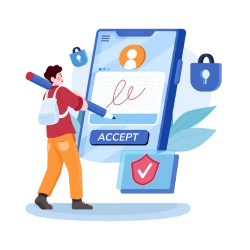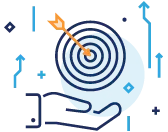Looking out for a fake check is necessary if you accept paper or electronic checks as payment for your business. In 2021, the Federal Trade Commission reported consumer fraud losses of more than $5.8 billion (which is up 70% from 2020). A solid portion of these losses stems from check fraud.
Although writing a check may seem traditional to some, they are still a major form of payment, especially in the B2B business world. However, a fraudulent check is a classic and prime tactic for fraudsters.
In this article, we are going to take a deep dive into counterfeit checks. You’ll know how to find a fake check, what happens if you unknowingly deposit a fake check, and how to prevent yourself from falling victim to check fraud.
What Is Check Fraud?

According to US Legal, check fraud is defined as “a criminal act which involves the unlawful use of checks to illegally acquire or borrow funds that do not exist within the account balance or account holder’s legal ownership.”
In other words, check fraud is the term used when someone gets money from a check that is not valid. A check is considered invalid when it is a completely fake check, an unauthorized alteration to an otherwise valid check, or a stolen valid check cashed by someone other than the person it’s issued to. Since the modern consumer uses checks for a multitude of practical reasons, the perils associated with check fraud are indeed very serious, and must be treated as such.
How Does Check Fraud Work?
Unfortunately, check fraud comes in many forms. This means you’ll need to be vigilant when accepting a check from an untrusted source.
Check fraud can be as simple as someone changing the amount on a check, or as elaborate as “washing” a check (i.e., using chemicals to erase the original text and replacing the amounts and/or recipients).
How to Tell if a Check Is Fake
Learning how to spot a fake check is a hard thing to do. Modern technology has made it easier for hackers to come up with realistic-looking fake checks. However, it is not impossible to ensure a check is legitimate as there are many signs that you can look out for.
Real check vs fake check
| Real | Fake | |
|---|---|---|
| Bank logo | Easily visible bank logo | No bank logo is seen or it is an unrecognizable bank |
| Bank address | A real bank address that is verified on google | The address is showing as a P.O. box online |
| Edges of the check | Perforated edge from being ripped out of a personal checkbook | Smooth edges may indicate that the check was printed from a home computer. |
| Check number | The check number matches the check number on the MICR line | The MICR line and check number do not match |
| Paper type | Check paper feels thick and sturdy | Check paper feels lightweight and flimsy |
| Routing number | The routing number is 9 digits long and has been verified from an online search to match the bank it is coming from | The routing number is not matching the bank seen on the check, is not the right number of digits, and does not match the MICR line |
| Signature | A real signature will have consistent pressure throughout and will not look faint | Looks slightly strange or digital |
| Amount | It is possible to have a check with an amount lower than $5,000 | Counterfeit checks are usually less than $5,000 in value because that number clears in five or fewer business days |
| MICR (magnetic ink character recognition) line | Check number and routing number match the MICR line. Appears dull | Appears shiny |
Beyond these specific details, you should look at the check as a whole for signs of alterations before accepting it. If you still cannot decide if the check you’re looking at is real, you can always contact the bank and ask for check verification.
How Do Banks Handle Counterfeit Checks?
If your bank finds that you have deposited a counterfeit check, they typically freeze or completely close your account. You should contact your bank immediately if you discover that a check was counterfeit.
Finally, if someone tampers with a check issued by you or your business, contact your bank to alert them of the problem. Your bank may contact you first for any extreme discrepancies.
Different Types of Check Fraud
Fraudsters can commit fraud in a number of ways, including (but not limited to) the following:
- Theft: When an individual steals checks either from a person, the mail, or home and uses them.
- Forgery: Forgery is when an individual alters or signs for a check that is not theirs.
- Chemical alteration: Using chemicals to erase details on a check to change the amount or recipient.
- Paper hanging: This is when an individual knowingly writes bad checks from their account.
- Counterfeiting: Counterfeiting is illegally printing checks.
- Identity theft: When someone opens an account in someone else’s name and writes checks from that account.
- Check kiting: The account holder writes checks from a bad account and deposits the money in another account, giving the illusion that money is in the second account and on its way.
Who is Typically the Target of Check Fraud Scams?
The short answer is everyone. Check fraud is a problem for people of all ages, but the Better Business Bureau reported people between the ages of 20 and 29 are the most common target.
What to Do if You’re a Victim of Check Fraud
If you are in the unfortunate situation where you or your business has become a victim of check fraud, you’ll need to take action. To correct the issue with as little damage as possible, you should follow these steps.

Report the check fraud
First things first, report the problem. Contact your business bank first to stop any payment, then contact any other service or company involved in the incident. If you need to escalate the situation, you can also report the problem to the following organizations:
- Federal Trade Commission
- State Attorney General
- United States Postal Inspection Service (if stolen by mail)

Attempt to stop the payment
Once you realize that you have been given and/or deposited a fake check, it’s often too late to do anything that will stop the payment. But it’s better if the check is not cashed, so it’s always worth a shot. Contact all parties involved to attempt to stop the money transfer.

Contact creditors immediately
The process to recoup your funds can take time. To avoid a lapse on any payments that depended on this check, if applicable, you should contact creditors immediately and let them know the situation. You may need to take out a small personal loan or contact family or friends to borrow funds until the issue is resolved.

Start a fraud alert
You can put a fraud alert on your personal and/or business credit report and bank accounts. Credit reporting companies and your bank will then closely monitor your profile to ensure there is no additional tampering. Make sure that these companies have updated and good contact information so they can contact you quickly if anything fishy arises.
How to Prevent Check Fraud
It’s not always easy to tell when a check is fake so don’t beat yourself up if you or your staff miss it. Scammers have gotten good at altering checks, but we have a few guidelines to follow if you are suspicious:
- Only accept checks from people you know
- Send checks to trusted vendors, contractors, and employees
- Never cash a check you weren’t expecting
- Do not wire money to people or businesses you don’t know
- Verify a cashier’s check before you cash it
- Keep detailed records of checks you issue so you can verify the correct amount comes out of your bank account
There are some additional tactics scammers try to use to commit check fraud. If you are in any of the following situations, be cautious:
- You were told you won a contest you never entered
- They ask you to send money to ship a free “prize” you won
- Someone asks you to purchase gift cards as a form of payment or reimbursement
- You are requested to send money to a different country
- Someone pays you with a check that shows a higher sum than owed
- You are being pressured to send money immediately
All these situations are common with fraudsters. Proceed with caution, or ignore them altogether.
Final Thoughts on Check Fraud
Check fraud is a serious issue in the United States. It’s a crime anyone can be a victim of, no matter how careful you are. Follow the safety guidelines in this article or consider a full-service eCheck payment processor that offers advanced fraud tools for your business. eCheck payment gateways are designed to detect fraudulent checks with built-in fraud software.
Stop fraud in its tracks
Prevent security issues with an eCheck payment gateway
secure
Check Fraud FAQs
Here are some frequently asked questions we hope will tie up any loose ends/questions you still have about check fraud.
Is check fraud a felony?
Check fraud can be a felony or a misdemeanor based on the situation and state you live in. Most of the time, the prosecution must show that the accused intended to deceive others by writing a bad check for it to be considered a felony. The amount of fraud also plays a role in this decision. In many states, fraud under the amount of $500 is a misdemeanor.
What happens if you unknowingly deposit a fake check?
There can be many consequences of unknowingly depositing a fake check. You may have to repay the amount the check was deposited for. Additionally, your bank can freeze or even close your account. Take check fraud seriously to avoid these potential consequences.
What does a fake check look like?
Determining what a fake check looks like can be very difficult. It is hard for an untrained eye to know what to look for, but here are a couple of common signs of a fraudulent check:
- Take a look at the bank address on the check. If there is no physical address and it shows as a P.O. box, we recommend you give the bank a call to verify.
- If you do not recognize a bank logo or it looks faded, we recommend you contact the bank to verify its legitimacy.
What measures are used to prevent check fraud?
The best thing you can do is educate yourself on situations where check fraud occurs. Below are a few measures you can take to help protect you and your business from check fraud:
- Keep your checks safe. Do not leave them in the car where they are visible from the outside and can get stolen.
- Monitor your bank account and statements. If anything is out of the ordinary, contact the bank immediately.
- Verify that all invoices from vendors and checks from customers are legitimate. Don’t issue a check to a vendor you don’t recognize and cautiously review checks written by new customers.
- Consider accepting eChecks. eChecks are overall safer for businesses.
Is there a way to verify a check?
Yes, one of the best ways to verify a check is to contact the bank listed on the check using the contact information on their website rather than what’s on the check. They can confirm the routing and account number or even the account holder’s name. You should also review the nine signs we touched on earlier to verify that a check is real.
What happens if someone else deposits a fake check into my account?
If someone else deposits a fake check into your account, you are responsible for it. First, you will need to contact your bank to secure access to your account and ensure only those authorized on the account can make a deposit. Then, you may have to repay the amount that was deposited.
What happens if you mobile deposit a fake check?
A mobile deposit or eCheck is just like a regular check. Just like in the case of a physical check, you will need to secure your account, contact your bank to alert them of the issue, and prepare to repay the amount. We recommend looking into tools to verify electronic checks.






